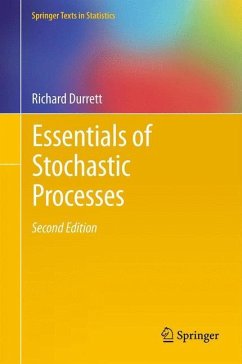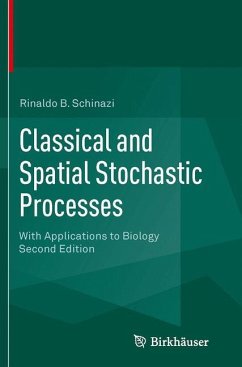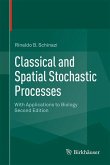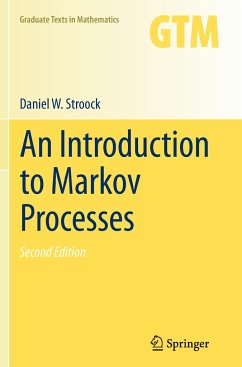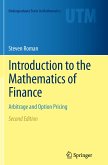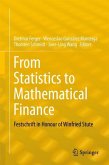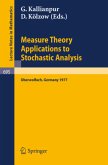This book is for a first course in stochastic processes taken by undergraduates or master's students who have had a course in probability theory. It covers Markov chains in discrete and continuous time, Poisson processes, renewal processes, martingales, and mathematical finance. One can only learn a subject by seeing it in action, so there are a large number of examples and more than 300 carefully chosen exercises to deepen the reader's understanding
The book has undergone a thorough revision since the first edition. There are many new examples and problems with solutions that use the TI-83 to eliminate the tedious details of solving linear equations by hand. Some material that was too advanced for the level has been eliminated while the treatment of other topics useful for applications has been expanded. In addition, the ordering of topics has been improved. For example, the difficult subject of martingales is delayed until its usefulness can be seen in the treatment of mathematical finance.
Richard Durrett received his Ph.D. in Operations Research from Stanford in 1976. He taught at the UCLA math department for nine years and at Cornell for twenty-five before moving to Duke in 2010. He is the author of 8 books and almost 200 journal articles, and has supervised more that 40 Ph.D. students. Most of his current research concerns the applications of probability to biology: ecology, genetics, and most recently cancer.
The book has undergone a thorough revision since the first edition. There are many new examples and problems with solutions that use the TI-83 to eliminate the tedious details of solving linear equations by hand. Some material that was too advanced for the level has been eliminated while the treatment of other topics useful for applications has been expanded. In addition, the ordering of topics has been improved. For example, the difficult subject of martingales is delayed until its usefulness can be seen in the treatment of mathematical finance.
Richard Durrett received his Ph.D. in Operations Research from Stanford in 1976. He taught at the UCLA math department for nine years and at Cornell for twenty-five before moving to Duke in 2010. He is the author of 8 books and almost 200 journal articles, and has supervised more that 40 Ph.D. students. Most of his current research concerns the applications of probability to biology: ecology, genetics, and most recently cancer.
From the reviews of the second edition:
"The book consists of six chapters and 265 pages. ... Each chapter has a chapter summary before the exercises. The chapter summary restates the theorems of each section and adds short new commentary. ... With its many examples and applications, chosen from the broad experience of the author, this book is an excellent text for a course in applied probability." (Myron Hlynka, Mathematical Reviews, February, 2014)
"This is the second edition of introductory text book on stochastic processes by Richard Durrett. ... The new edition contains many new examples and problems. The chapters have been reorganized to facilitate the learning process. ... The new edition makes the topic of stochastic processes even more accessible for undergraduate students and people coming from fields of applications." (H. M. Mai, Zentralblatt MATH, Vol. 1244, 2012)
"The book consists of six chapters and 265 pages. ... Each chapter has a chapter summary before the exercises. The chapter summary restates the theorems of each section and adds short new commentary. ... With its many examples and applications, chosen from the broad experience of the author, this book is an excellent text for a course in applied probability." (Myron Hlynka, Mathematical Reviews, February, 2014)
"This is the second edition of introductory text book on stochastic processes by Richard Durrett. ... The new edition contains many new examples and problems. The chapters have been reorganized to facilitate the learning process. ... The new edition makes the topic of stochastic processes even more accessible for undergraduate students and people coming from fields of applications." (H. M. Mai, Zentralblatt MATH, Vol. 1244, 2012)
"It is the 3rd edition of the textbook devoted to initial information and basic topics from the theory of stochastic processes. ... The book is very useful for anyone who is interested in probability theory and its ramifications and applications. It can be recommended both for students and postgraduates, teachers and practitioners. ... The book contains a lot of examples which contribute to a better understanding of the text." (Yuliya S. Mishura, zbMATH 1378.60001, 2018)
"This is the third edition of a popular textbook on stochastic processes. It is intended for advanced undergraduates and beginning graduate students and aimed at an intermediate level between an undergraduate course in probability and the first graduate course that uses measure theory." (William J. Satzer, MAA Reviews, maa.org, February, 2017)
"This is the third edition of a popular textbook on stochastic processes. It is intended for advanced undergraduates and beginning graduate students and aimed at an intermediate level between an undergraduate course in probability and the first graduate course that uses measure theory." (William J. Satzer, MAA Reviews, maa.org, February, 2017)

